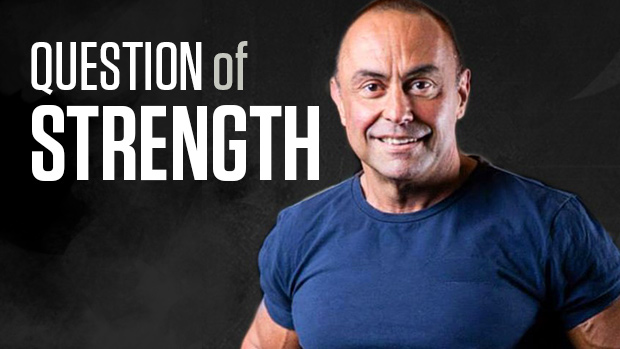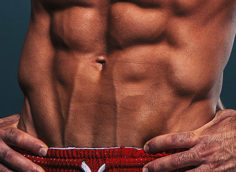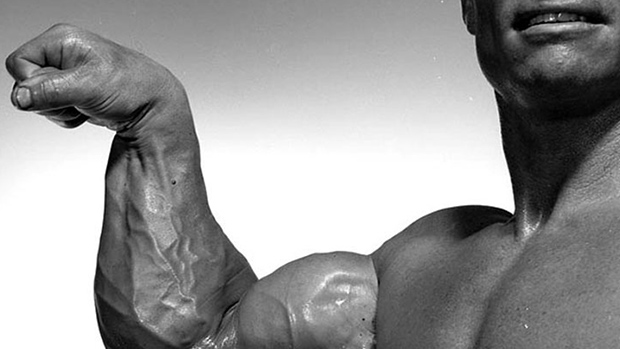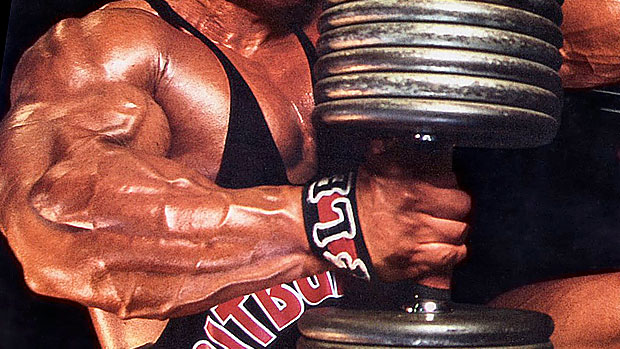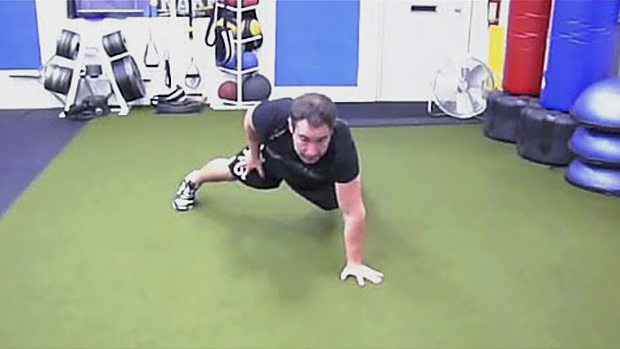Delusional Fat Guys, Calipers, and Laser Guns
T Nation: How low does your body fat percentage generally need to be in order to start seeing abs?
Answer: The magic number is 9.8%. Now, there are a lot of people who see imaginary abs, but one row doesn't count. The upper row of the abdominals can show up at 15%.
If you can see the linea alba (which means the "white line" ) – the vertical line in the middle of the rectus abdominis – that's at least 9.8%. In other words, you'd see all the rows.
I remember one professional baseball player in Sports Illustrated claiming to be 6% body fat. There was a picture of him in the article and he was more like 17%. At 6% you'd be able to see the guy's pancreas make insulin.
People like this are either delusional, using poor body fat measuring devices, or using a sloppy testing protocol. Those electrical impedance devices, the Bod Pod, etc. all tend to be quite inaccurate. If you're skilled with a pair of good calipers, you can be within a half a percent of a DEXA scan, which is now the industry standard.
The research and my experience shows that it takes about 4000 subjects before you're accurate with a pair of calipers. You just have to do a lot of them to develop the skill. When we teach Biosignature, we harp on the students all day on how to do it properly.
By the way, we're evaluating what could be the future of body fat testing right now: laser guns. Basically, a monkey could test body fat with this method. The only limiting factor is if the person can find the anatomical markers, but that's not that complicated. You point the gun and the laser measures the skinfold.
One of the problems with skinfold calipers is, how much do you pinch? This is especially true when dealing with the obese. People I deal with want to go from 12% to 5%, but some people are starting out at 40%! They're morbidly obese.
And here's something else to think about: ingesting a lot of trans fat changes the composition of body fat – it's harder to pinch. Ask any experienced tester. If you pinch test someone who eats a lot of French fries and chicken nuggets, his fat feels a lot different. So in that case, the tester has to be very skilled and have a kung-fu grip worthy of one leaving the Shaolin temple.
There's a reason why the medical division of the National Academy of Science says that the only safe level of trans fat is zero: it actually changes the cell structure. Our body doesn't know what to do with it.
Now, as far as what calipers are best, you need to spend $400 to $600. I like the Harpenden Skinfold Caliper.
T Nation: My triceps suck no matter how many rope pulldowns I do. Help!
Answer: You need to stimulate every muscle in the triceps. Most people neglect the lateral head, which is often called the "lazy head" of the triceps.

The lateral head needs heavier loads to respond. The two exercises that have been shown to cause the most motor unit recruitment are dips and decline close-grip bench press with the elbows out (elbows under the bar, like you're doing the chicken dance).

The biceps also have a neglected muscle: the long head. The long head is stimulated by any form of curl where the elbows are behind the torso, so that means incline dumbbell curls.
Most people avoid this exercise because they have to lower the load in the incline position. The result of this inability to leave their ego in the locker room? Incomplete arm development.
T Nation: What's the best book you've read for personal improvement that wasn't diet or training related?
Answer: There are a lot of good ones. The Greatness Guide by Robin Sharma is one.
He gets to the point in this book with short chapters and not a lot of fluff. This guy's books have been translated into hundreds of languages, and he's lectured all over the world.
One I've read recently is The Success Principles by Jack Canfield.
The 4-Hour Workweek by Timothy Ferriss is also good.
T Nation: I'm a female who stores all her body fat in her middle. No fat legs, no fat butt, just belly and "muffin top." What does this say about my hormonal profile? How should I eat?
Answer: Based on our Biosignature Modulation data, you're most likely pre-diabetic. Therefore, you need to go on a low-carb diet and take supplements that increase your insulin sensitivity: alpha lipoic acid, fenugreek, and omega-3s to name a few.
Don't eat foods past 50 on the Glycemic Index. More importantly, avoid high insulin loading foods. For example, dairy products are low-glycemic but high insulin load, so obviously stay away from dairy. Fat people shouldn't drink milk!
Insulin load index (or Glycemic Load) is a better barometer than the Glycemic Index. For example, carrots have a high glycemic index, but you'd have to eat a field of them to get that effect. The insulin load is actually small.
Now, for females, waist size should be 70% of the hip size. If it's 85% – which isn't a big difference – she's nine times more likely to get diabetes.
Dr. Mark Houston from the Hypertension Institute in Nashville has a paper on this coming out soon. We'll be introducing new cardiovascular risk factors. Basically, it's waist divided by height. If you have a big waist for your height, you're more likely to get the big three: hypertension, dyslipidemia, and diabetes.
For more information on how body fat stores relate to hormonal make-up, and what to do about it, check out my Biosignature Modulation seminars.
T Nation: Should we really be worried about cortisol? If so, how can we decrease it?
Answer: We should be worried about cortisol, and not just because of its catabolic effects on muscle. For one thing, the overproduction of cortisol has been linked to brain aging.
If you run on cortisol for too long, it will actually shrink the hypothalamus, the vital part of the brain for memory. By the way, athletes who produce the highest amount of cortisol – which are rowers and cross country skiers – also have a high incidence of Alzheimer's.
Cortisol is a double-edged sword of a hormone. You need it for energy, but if you have too much it can break down tissue. Morning is a good time to have cortisol; it's basically what wakes you up and gets you going. But people who've been stressed for too long have what they call "low morning energy." They push the snooze button fifty times. That can be a sign of low cortisol.
Your cortisol should be high in the morning and low at night. When people get stressed this tends to reverse: low in the morning and high at night. After a while it's low all the time; they have low energy and depression.
But it's well documented in the literature that the less cortisol you have and the more anabolic hormones you have, the more progress in the gym you'll make.
Is cortisol controllable? Yes. The post-workout drink is your basic tool to control cortisol produced by training.
Anything that will mitigate how much cortisol you produce in a day will make a big difference. For example, just seven grams of fish oil a day has been shown in a French study to mitigate the amount of stress hormones a person produces. Rhodiola rosea and Siberian ginseng, which are known as adaptogens, can help mitigate cortisol as well.
Interesting note: Wales, Ireland, and England have the highest rates of depression in the world, and they also have the highest levels of omega-3 deficiency. Omega-3 raises serotonin in the brain. There have been over 600 studies coming out on depression and omega-3s in the last two years alone. So, yet another good reason to use fish oil.
If you're serious, you can get an Adrenal Stress Index test done. Some people claim it takes up to a year and a half to pull someone out of serious adrenal fatigue, but I've done it in eight weeks. You just have to do the right things.
T Nation: What do you think of the pullover? Good exercise? What does it work anyway? I see it in chest and back programs.
Answer: It actually works the back and the chest, and a portion of the serratus.
The best way to perform a pullover is in the decline bench, positioned as you would be if performing the decline bench press. This allows you to have greater time under tension because you're overloaded for longer periods of time.

Also, perform the pullover last so your lats will be pre-fatigued and it will be kinder to your shoulder joints. So for example, do chins, then rows, then pullovers. I like doing pullovers for higher reps, 20 to 25 reps.
You can perform the pullover with a barbell, dumbbells, or even a pulley.
T Nation: Why do some people perform bench presses with their feet elevated or their knees up? Any benefit to this?
Answer: If you really don't like someone, tell them to bench with their feet up.

Some people argue that it isolates the pecs better, but the only thing I've seen with it is some pretty nasty accidents.
Others argue that benching with the feet up or knees elevated is safer for the spine because it flattens it. But this isn't an issue as long as you're not using a bench that's four feet off the ground. I'd rather be stable by having my feet on the floor, and be able to react quickly in case of uneven arm extension.
You see this in colleges a lot – guys choosing to lift with their legs up to be fancy (and therefore choosing not to lift a lot of weight). I've seen this lead to major facial reconstruction, not because the bar hit the lifter, but because a nearby lineman who got hit on the foot by the plate punched the guy out!
So, I don't advocate this.
T Nation: I want to get into fat-grip training. What are your favorite implements for this?
Answer: The best company for fat-grip training is Black Iron. They make fat-handled rotating bars and dumbbells, even pulldown bars and kettlebells.
One of my students has also come up with a new magnetized grip attachment. It's not yet commercially available, but if anyone is interested they can contact him at bradypowers1@hotmail.com.
I'd still prefer to buy a fat bar, but the aforementioned can be good if you train in a commercial gym.
T Nation: On the cover of your Ask Coach Poliquin book, there's a very large guy doing seated overhead presses, but his hands are facing each other at the top. Why?
Answer: His name is Ethan Brooks and he used to play for the Baltimore Ravens.

His palms are facing each other on the overhead dumbbell press because this is anatomically easier on the shoulders than the usual grip. That doesn't mean you should never do a pronated grip, but an athlete will get better results taking it easy on the shoulders after the competitive season.
T Nation: I need emergency shoulder width. Got a fast-results routine to get me wider?
Answer: Wide, round shoulders have been built both with high loads and with high volumes. Powerlifters and Olympic lifters have built impressive shoulders using low reps for multiple sets on compound exercises such as presses and upright rows.
On the other hand, there are plenty of bodybuilders out there with fantastic deltoid development who've reached their levels of development with high reps, short rest intervals, and mainly isolation-type movements.
People will achieve better deltoid development if both approaches are cycled in and out. I find that descending sets and the pre-exhaustion method are particularly effective at promoting shoulder growth.
When someone has problems growing in the mid-delt area, I find that tri-sets or omni-rep breakdown sets are indicated. Tri-sets are an extended series of three exercises performed one after another before taking a prescribed rest interval. A good tri-set for the mid-delts would include:
| Exercise | Sets | Reps | Tempo | |
| A1 | Standing Lateral Raises | 3 | 8-12 | 40X0 |
| A2 | Low Pulley Upright Rowing | 3 | 8-12 | 40X0 |
| A3 | Seated Dumbbell Presses | 3 | 8-12 | 40X0 |
Perform a set of exercises A-1, A-2, and A-3 in a series before taking a two minute break. Repeat the process until all three tri-sets are done.
On the standing lateral raises, the concentric range should be performed explosively (X) as the leverage is disadvantageous in this exercise.
I recommend using a rope, like the one normally used for pressdowns, for your low-pulley upright rowing. This will take away the stress on the wrists.
For an omni-rep breakdown set, you select one basic exercise and its variation and basically destroy all the fibers that can be used in this movement:
- Do 6-8 RM of the one-arm standing lateral raises with a 20X0 tempo. In this set you'll target the highest threshold fibers in your delts.
- Do 10-12 RM on the lean-away one-arm standing lateral raises with a 20X0 tempo. By changing the mechanics you'll take most of the supra-spinatus muscle out of it and change the point where the resistance is, and subsequently the strength curve for the medial deltoid. You'll also tap into the intermediate fast glycolitic fibers.
- Do 20-25 RM on the low-pulley lateral raises with a 1010 tempo. By using a low pulley, you'll be able to put more even tension throughout the movement. The higher reps will finish off whatever low threshold fiber that can still fire after steps 1 and 2.
Don't rest between steps 1 to 3. Take a 90 second break and repeat with the other arm until three sets of the omni-rep set are done per arm.
Note: These routines are reserved for high-pain threshold individuals. Wimps stay from this routine!
Try each one of these routines for six workouts each and I'm sure your deltoids will take on some new mass!

